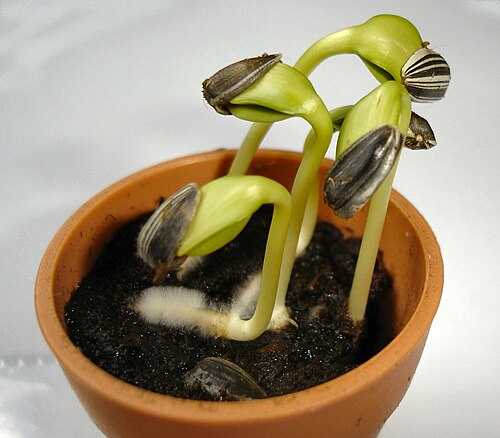Facts for Kids
Germination is the exciting process that occurs when a seed begins to grow into a new plant, requiring water, warmth, and sometimes light.
Overview
Types Of Seeds
Respiration In Seeds
Stages Of Germination
Temperature And Germination
Role Of Water In Germination
Common Germination Techniques
Factors Affecting Germination
Seed Dispersal And Germination
Light Requirements For Germination
Environmental Impact On Germination

Inside this Article
Respiration
Temperature
Gardening
Israel
Second
People
Winter
Light
Food
Day
Are
Did you know?
🌱 Germination starts when a seed begins to grow into a new plant!
🌊 The first stage of germination is called imbibition, where the seed absorbs water.
🌱 The shoot grows upwards while the tiny root called radicle grows downwards during germination.
🌼 Photosynthesis begins at the establishment stage, where leaves and roots develop.
🌡️ Seeds require the right conditions of water, temperature, light, and air to germinate well.
💧 Water is essential for seeds to absorb and trigger the germination process.
☀️ Some seeds, like lettuce, need light to germinate, while others can grow in darkness.
🌾 There are two main types of seeds: dicots with two seed leaves and monocots with one seed leaf.
🌍 The environment, including soil quality and moisture, greatly affects how seeds germinate.
🌬️ Seeds need to be dispersed to new locations to sprout into new plants.
Introduction
It happens when the right conditions meet, like having enough water, warmth, and sometimes light. Seeds are like little packages that contain everything a plant needs to grow. Did you know that the oldest seed ever to germinate was found in Israel and was over 2,000 years old? 🌍
Germination can happen in many plants, including flowers, vegetables, and trees. Understanding germination helps us learn how to grow food and keep our environment healthy!
Types Of Seeds
Dicots have two seed leaves and include beans and sunflowers. Monocots have only one seed leaf, like corn and grasses. These two types grow differently, with dicots often having broad leaves and monocots having long, narrow leaves. 🌾
Each type of seed is designed to adapt to its environment, helping them survive and grow! Knowing the types of seeds can help us understand the plants we see every day!
Respiration In Seeds
They breathe through a process called respiration. During germination, seeds take in oxygen and use it to convert stored food into energy—just like we do when we eat! 🍎
This energy helps the seed grow roots and shoots. If seeds don’t have enough oxygen, they may not sprout at all. So while they may seem quiet, they are actually working hard underground!
Stages Of Germination
The seed coat breaks open, and a tiny root called the radicle starts to grow downwards. The second stage is called emergence. 🌱
The shoot begins to grow upwards, looking for light. Finally, the last stage is called establishment, where the young plant develops leaves and roots to start photosynthesis and grow bigger! 🌼
All these stages are crucial for a healthy plant to develop!
Temperature And Germination
️ Most seeds prefer mild temperatures between 65°F to 75°F (18°C to 24°C) to sprout. If it’s too cold, the germination process slows down, and the seed might even go dormant! 🥶
When seeds are in warmer temperatures, they are more likely to grow quickly. However, if it’s too hot, it can damage the seed. Finding the perfect balance helps seeds germinate and grow into healthy plants!
Role Of Water In Germination
When seeds absorb water, it triggers the germination process. This process helps the seed swell and break its outer shell. If there isn't enough water, the seed may not sprout. 💦
Sometimes, seeds also store food to survive until they find enough water and sunlight. Just like people need water to stay healthy, seeds need it too to grow into strong plants! 🌻
Without water, plants cannot live!
Common Germination Techniques
They often soak seeds in water to kick-start the process. Some people even use special materials like paper towels or peat pots to help seeds sprout. Another method is called “cold stratification,” where seeds are placed in a cool environment to mimic winter. ❄
️ This helps seeds that require cold temperatures in their natural habitats. Understanding these techniques makes growing plants easier and more enjoyable! 🌻
Factors Affecting Germination
️ These include water, temperature, light, and air. Seeds require moisture to swell and break open. If it’s too hot or too cold, seeds might not sprout. Also, some seeds need light, while others prefer darkness. 🌞
Lastly, good air circulation helps seeds breathe, which is essential for healthy growth! Each type of seed has its unique needs that help it germinate effectively.
Seed Dispersal And Germination
Some seeds are carried by the wind, while others stick to animals or are eaten and later passed out in another place. 🌬
️ For example, dandelion seeds have fluffy tails that let them float away in the breeze! The way seeds are dispersed affects where they germinate and how well they grow. 🌼
This process ensures that plants can grow in new areas, helping to create a diverse and healthy ecosystem!
Light Requirements For Germination
️ Some seeds, like lettuce, actually need light to sprout. They are called “light-sensitive” seeds. Other seeds, like sunflowers, can grow in the dark and still emerge when the light returns. 🌼
Each plant has its preference for light, and understanding these needs helps gardeners know the best way to plant them. Light is essential for photosynthesis, the process plants use to make food!
Environmental Impact On Germination
If a seed is planted in rich soil with plenty of nutrients, it has a better chance to sprout. However, if it’s planted in poor soil, the seed may struggle to grow. 🌱
Other environmental factors like rainfall, sunlight, and nearby plants also affect how well a seed germinates. Understanding these factors helps us protect our environment and improve gardening!

